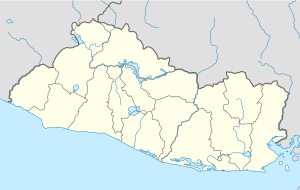Tacuba (El Salvador)
| Tacuba | ||
|---|---|---|
|
Coordinates: 13 ° 54 ' N , 89 ° 56' W Tacuba on the map of El Salvador
|
||
| Basic data | ||
| Country | El Salvador | |
| Department | Ahuachapán | |
| Residents | 29,858 (2007) | |
| Detailed data | ||
| surface | 149.98 | |
| height | 699 m | |
| Time zone | UTC −6 | |
| City Presidency | Joel Ernesto Ramírez Acosta ( ARENA ), 2009–2012 | |
Tacuba ( Nawat : Takupan ) is a municipality in El Salvador in the Ahuachapán department . It is located in the far west of the country not far from the border with Guatemala .
Surname
A widespread interpretation of the Nawat name Takupan is "place of the ball game " (cf. Nahuatl tlach (tli) "ball, ball game", the location -co and -pan "on"). A connection with tlacōtl "rod" is also possible. The place should not be confused with the district of the same name in Mexico City , the old Tlacopan , which may have an identical origin, but is traditionally interpreted as “flowering plant on a flat ground”.
history
The old tacupan was founded by the Pipil . Around 1200 the area came under the rule of Cuzcatlan .
The former rule of Cuzcatlan was finally conquered by the Spanish in 1528. In 1550 Tacuba had about 500 inhabitants. During the entire colonial period it belonged to the Provincia de los Izalcos or Alcaldía Mayor de Sonsonate . In 1770 there were about 996 indigenous people in 351 families in the village of Tacuba, which was subordinate to the pastor of Ahuachapán. The town's church was destroyed in an earthquake in 1773 .
In 1824 Tacuba first came to the department of Sonsonate . With the creation of the Ahuachapán Department on February 9, 1869, it was attached to the same. Around 1890 it had 3340 inhabitants.
In the 19th century, Tacuba became a center of coffee growing . By two government decrees by President Rafael Zaldívar in 1881 and 1882, the property rights of the indigenous communities in El Salvador were revoked and the jointly managed ejidos were dissolved. As a result, the large landowners also expanded their coffee plantations in Tacuba at the expense of the indigenous people.
In 1932 Pipil farmers from Tacuba took part in the uprising against the large landowners and the military rule of General Maximiliano Hernández Martínez . After the suppression of the uprising, the Matanza , a massacre that killed around 30,000 people in all of El Salvador in early 1932, over a quarter of the total population in Tacuba, almost every man over 12 who could not escape. The mass shootings lasted for about a month. The Nawat language of the Pipil was subsequently banned and brought to the brink of extinction within a few decades.
Pipil culture today
Tacuba is the only municipality in the department of Ahuachapán where there are still some speakers of the Pipil language Nawat , which has been brought to the brink of extinction as a result of the harsh repression since the Genocide on the Pipil in 1932. But it can hardly be heard in everyday life because it is only spoken by a few old people.
Individual evidence
- ↑ Resultados Alcaldes Electos en El Salvador para 2009-2012 ( Memento of the original from December 28, 2010 in the Internet Archive ) Info: The archive link was inserted automatically and has not yet been checked. Please check the original and archive link according to the instructions and then remove this notice.
- ^ Paul D. Almeida: Organizational expansion, liberalization reversals and radicalized collective action. In: Harland Prechel (ed.): Politics and globalization 15, 2007, pp 57-97.
- ↑ Jeffrey Gould y Carlos Henríquez Consalvi: Video "1932. Cicatrices de la memoria". New York: First Run / Icarus Films, 2002. Film review 1932 - La memoria toma la palabra. ( Memento of the original from March 10, 2009 in the Internet Archive ) Info: The archive link was automatically inserted and not yet checked. Please check the original and archive link according to the instructions and then remove this notice.
Web links
- Tacuba - fisdl.gob (Spanish)
- Tacuba - elsalvadorturismo.gob (Spanish)

